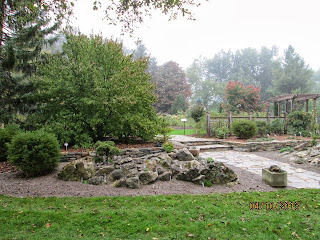Weekend Practical ,Cuddy Gardens, Oct 18-20 , 2013 Dan
Grady, Ben Hickey
Our first day at Cuddy started off well despite the cold,
first thing we did was meet up with Lucas and went over the tasks and went for
a walk to explain and give examples in greater detail. The first task we took
on was to clean up the debris from the walnut and apple trees that surround the
rock garden beside the house, this task was rushed because Eric who was cutting
the grounds grass needed to cut that area we went over it a second time later
in the day. Secondly we went after and pruned the Liquidambars at the front of
the house just for dead limbs this did not take long we did however find other branches
and debris around the gardens and collected them.
After a fifteen minute break we decided to go dead head the
day lilies and weed the iris at the iris border at the front of the property
again we were In the way of Eric cutting the grass so we had to save the rest
of the task till after lunch and we just watered and weeded the nursery stock
instead.
The Saturday was rainy, but we had a lot of work to do ,
especially on the Iris garden. We finished the edging at the iris garden the
best we could do to the circumstances with the weather. So while hoping for the
weather to cooperate a little better we did some housekeeping tasks Lucas
assigned us in the tool shed if it were
to rain and also worked on the plant profile. The rain started to ease off so
we decided to do a few tasks before the day was over, so we grabbed some rakes
and headed over to the woodland garden to rake. Only problem was all the wind
shaking the trees and making us extremely more wet also with the ground being
wet we were taking up a lot of the mulch on the walk way as well.
Our last day at Cuddys and like yesterday it was a cold one
, we started the day by finishing off the Iris garden edging , using the Dutch hoe and making it
look nice . This task was little difficult because it rained the previous day
and this made the soil very muddy. So I worked away on that and Ben took the
leaf blower and cleared off the walkways and driveway of leaves I think he
enjoyed himself. We took our lunch break to get some much needed energy, our
last task of the day was doing some last touches on the Iris garden and
cleaning up the rock garden and other areas.
Plant Profile Ben Hickey , Dan Grady
Cary glabra
( pignut Hickory)
Ben and Dan’s opinion :
An all and all nice tree, not too showy but still pretty with it rich
green foliage and thick ridged trunk, good for most landscapes , beautiful fall
color and a good tree in any environment .
Family
– Juglandaceae
Genus
– Cary
Species
– glabra
Category
– Woody
Type
– Tree (deciduous)
Origin-
Native
Propagation
– Seeds should be soaked in water , you should also plant in 3 gallon pots
Habitat
– Hillsides , Climax forests , also ridges
Shape
–
Tapering trunk and a slender controlled branches
Growth
– Tree can reach 60-50 ft in height , and 25-30 in spread
Flowering
Period – May
Cultivation
–
Tree prefers well drained to dry , fairly rich soils
Pests
–
Tent caterpillars
Notable
specimens –
ID
Characteristics – Tree has 5-6 leaflets, Green sharped
toothed ovate leaves , entire leaf is 8-12 inches long
General
Description – Tree is large with light green leaves
compound foliage
Flower
Description – Flowers are monoecious male has 7.5
drooping catkin , female has few flowering terminal spikes
Bark
Description – Tree has smooth grey brown bark on
young specimens , eventually bark shapes into diamond pattern
Leaf
Description – 5-7 leaflets each leaflets is 3-6
inches long , and 1-2 wide
Texture
Description -
Color
Description – Tree has lovely green foliage in the
summer and a nice gold yellow in spring
Sources
-
Manual
of Woody landscape plants 6th edition Michael A Dirr
-
"Canada
Plants." • Carya Glabra (Pignut Hickory). N.p., n.d. Web. 20 Oct.
2013.

























